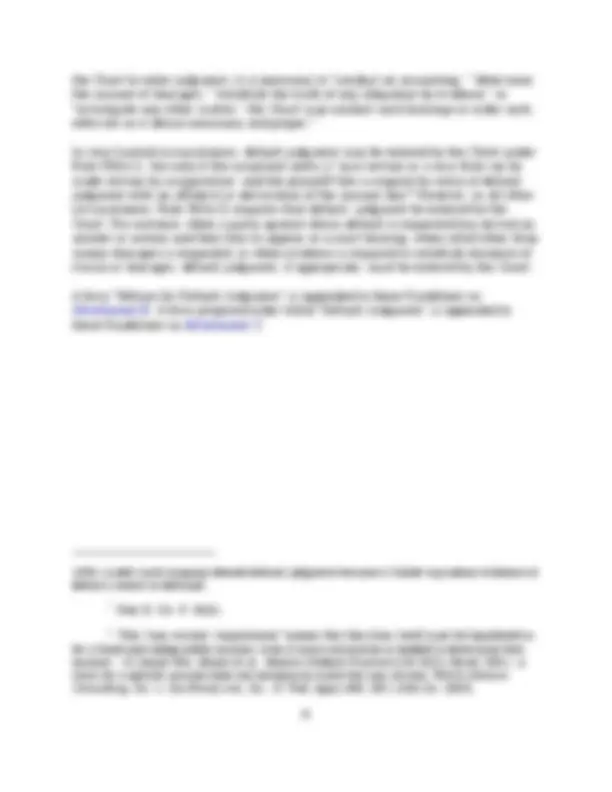



Study with the several resources on Docsity

Earn points by helping other students or get them with a premium plan


Prepare for your exams
Study with the several resources on Docsity

Earn points to download
Earn points by helping other students or get them with a premium plan
Community
Ask the community for help and clear up your study doubts
Discover the best universities in your country according to Docsity users
Free resources
Download our free guides on studying techniques, anxiety management strategies, and thesis advice from Docsity tutors
Guidelines for obtaining a default judgment in bankruptcy adversary proceedings. It outlines the two-step process of obtaining a default judgment: entry of default and default judgment. The requirements for filing a 'motion for entry of default by the clerk' and a 'motion for default judgment'. It also discusses the circumstances under which default judgment may be entered by the clerk or the court.
What you will learn
Typology: Exams
1 / 3

This page cannot be seen from the preview
Don't miss anything!


Judge Karlin’s GUIDELINES FOR OBTAINING A DEFAULT JUDGMENT Revised December 5, 2016
Pursuant to Federal Rule of Civil Procedure 55, made applicable to adversary proceedings by Federal Rule of Bankruptcy Procedure 7055, default encompasses two steps: (1) Entry of Default and (2) Default Judgment.^1
STEP ONE: Entry of Default
Local Rule 5075.1 authorizes the bankruptcy clerk to sign and enter default in adversary proceedings. Entry of default is a procedural formality, and a prerequisite to the issuance of a default judgment.^2 The party requesting an Entry of Default should file a “Motion for Entry of Default by the Clerk” with an affidavit, or other unsworn declaration made under penalty of perjury (e.g.,under 28 U.S.C.§ 1746), attached. That Affidavit or Declaration should set forth the following facts:
(^1) 10 James Wm. Moore et al., Moore’s Federal Practice § 55.10[1] (3d ed. 2001).
(^2) Id. ; see also Garrett v. Seymour , 217 Fed. App’x 835, 838 (10th Cir. 2007) (“[T]he
clerk had not entered default under Rule 55(a), a prerequisite for the entry of a default judgment under Rule 55(b)(1).”).
(^3) 50 U.S.C. § 3931(b) (emphasis added).
determine military status? 4
A sample “Motion for Entry of Default by the Clerk” with attached supporting Declaration is appended to these Guidelines as Attachment A.
STEP TWO: Default Judgment
The party seeking a default judgment should file a “Motion for Default Judgment” that sets forth that the party seeking default judgment is entitled to the relief sought based upon a proper showing of each element of each claim.^5
No notice of the Motion for Default Judgment must be provided to the defaulting Defendant unless the party has appeared personally or by a representative (and then did not file an answer or other responsive pleading). If an appearance has been entered, you must serve a copy of the motion at least 7 days before any hearing, as required by Fed. R. Civ. P. 55(b)(2). Accordingly, the Motion for Default Judgment need not be “noticed” unless there has been an appearance. If there has been an appearance, the Court will wait the requisite 21 days for response to the dispositive motion, pursuant to D. Kan. Rule 6.1(d)(2).
The Court will determine whether or not judgment should be entered and may set the matter for hearing in order to make such determination.^6 If, in order to enable
(^4) A party can request information from the Department of Defense (“DOD”) to
determine whether a person is in the military, and the DOD must issue a statement as to military service. 50 U.S.C. § 4012(b). Verification can be made electronically through the Defense Manpower Data Center (“DMDC”). The DMDC’s web site is located at https://www.dmdc.osd.mil, and their telephone number is (800) 467-5526.
(^5) See Bixler v. Foster , 596 F.3d 751, 762 (10th Cir. 2010) (“Even if an entry of default
had been appropriate, it would not have been sufficient to entitle plaintiffs to a judgment..
. Once default is entered, it remains for the court to consider whether the unchallenged facts constitute a legitimate cause of action, since a party in default does not admit mere conclusions of law. There must be a sufficient basis in the pleadings for the judgment entered.” (internal quotations and citations omitted)).
(^6) The Court may require an evidentiary hearing when a party seeks a default
judgment on allegations of fraudulent intent. See, e.g., AT&T Universal Card Servs., Corp. v. Sziel (In re Sziel) , 206 B.R. 490, 495 (Bankr. N.D. Ill. 1997) (expressing the court’s reluctance to “rubber stamp” default judgment motions when allegations of fraudulent intent are conclusory). Even if the party against whom default is requested fails to appear at such hearing, the movant must present evidence of fraud and the requisite intent. See, e.g., FCC Nat’l Bank v. Roberts (In re Roberts) , 193 B.R. 828, 831–32 (Bankr. W.D. Mich.
-2-